#layer-2 scaling solution
Explore tagged Tumblr posts
Text
Exploring Fault Proofs in Optimism: An Overview

The activation of fault proofs by Optimism marks a significant advancement in Ethereum Layer 2 scaling solutions, completing the first stage of its decentralization plan. This milestone is pivotal for enhancing the network's security and trustlessness, reducing reliance on centralized entities like the Optimism Security Council. Previously, the council monitored transactions and intervened to prevent fraud, but with the new fault proof system, any party can now challenge transactions, moving towards a more decentralized and inclusive network.
Ethereum's high transaction fees have made Layer 2 scaling solutions, such as rollups, essential. Optimism's fault proofs ensure that off-chain transactions are valid by allowing a challenge period where anyone can contest a transaction's validity. If a challenge is raised, a fault proof is provided and verified by the Ethereum mainnet, ensuring that invalid transactions are reverted.
This process significantly enhances the security and integrity of the blockchain. Unlike Arbitrum, which relies on 12 validators, Optimism's fault proof system is designed to be trustless and decentralized, enabling broader participation in transaction verification.
Despite initial challenges with proof generation and verification speeds, Optimism has optimized its fault proof mechanisms to be compatible with Ethereum's Layer 1. This achievement not only improves the security and decentralization of the network but also sets a benchmark for other rollup technologies.
The activation of fault proofs highlights the importance of continuous innovation and rigorous testing in the blockchain space. For more in-depth insights and exclusive research, join our Web3 Sync community on Intelisync and Learn more...
#Batching Transactions#Challenge Window#Challenges and Criticisms#Criticism Addressed#cryptographic proofs#Decentralization Roadmap#Ethereum Layer 2 scaling solutions#fault proof#fault proof mechanism#Fault Proofs Milestone#Future Outlook#How Optimism Worked Before Fault Proofs#Optimism Achieves a Major Milestone#Optimism Implements Fault Proofs#Optimism’s Decentralization Roadmap#optimistic and zk-rollups#Proof Verification#Reversion of Invalid Transactions#Technical Challenges#The Importance and Issues of Fault Proofs#The Necessity of Layer 2 Scaling#Understanding Fault Proofs in Optimism#blockchain development companies#web3 development#metaverse development company#blockchain development services#metaverse game development#web 3.0 marketing#crypto app development#cryptocurrency development companies
0 notes
Text
Unlocking Ethereum's Potential with Exploring Layer 2 Scaling Solutions
As the demand for decentralized applications (DApps) and non-fungible tokens (NFTs) continues to soar, the limitations of Ethereum's scalability have become increasingly apparent. Ethereum, the pioneering blockchain platform for smart contracts and DApps, has faced challenges such as high gas fees and network congestion due to its limited transaction throughput. To address these issues and unlock Ethereum's full potential, various Layer 2 scaling solutions have emerged. In this blog, we delve into the significance of Layer 2 solutions, explore different types, and assess their impact on Ethereum's scalability and usability.
Understanding Layer 2 Scaling Solution
Layer 2 scaling solutions are protocols or frameworks built on top of the Ethereum blockchain, designed to enhance its scalability by processing transactions off-chain or through alternative mechanisms. Unlike traditional on-chain transactions, Layer 2 solutions aim to reduce the burden on the Ethereum mainnet, thereby increasing transaction throughput and reducing costs. These solutions facilitate faster and cheaper transactions while maintaining the security guarantees of the Ethereum network.
Types of Layer 2 Scaling Solutions
State Channels: State channels enable participants to conduct off-chain transactions directly with each other, updating the state of their interactions off-chain. Once completed, the final state is then recorded on the Ethereum mainnet, minimizing the number of on-chain transactions required. Projects like Raiden Network and Celer Network utilize state channels to enable instant micropayments and scalable token transfers.
Plasma: Plasma is a framework for building scalable decentralized applications by creating hierarchical tree structures of sidechains, also known as "child chains," anchored to the Ethereum mainnet. These child chains can process transactions independently, with the final state periodically committed to the Ethereum mainnet for security. Projects like OMG Network (formerly OmiseGO) leverage Plasma technology to achieve high transaction throughput and low fees.
Rollups: Rollups are Layer 2 scaling solutions that bundle multiple transactions into a single compressed data structure, known as a "rollup," which is then submitted to the Ethereum mainnet for verification. There are two types of rollups: optimistic rollups and zk-rollups. Optimistic rollups rely on fraud proofs, allowing users to challenge incorrect data submissions, while zk-rollups utilize zero-knowledge proofs for efficient data verification and privacy. Prominent projects such as Arbitrum and zkSync employ rollup technology to significantly enhance Ethereum's scalability without compromising security.
Benefits of Layer 2 Scaling Solutions
Improved Scalability: By offloading transactions from the Ethereum mainnet, Layer 2 solutions dramatically increase the platform's scalability, enabling thousands of transactions per second.
Reduced Gas Fees: With fewer transactions processed on-chain, gas fees are substantially lowered, making Ethereum more accessible for users and developers alike.
Enhanced User Experience: Faster transaction confirmation times and lower costs improve the overall user experience, driving adoption of DApps and NFTs on the Ethereum ecosystem.
Environmental Sustainability: Layer 2 scaling solutions contribute to reducing Ethereum's carbon footprint by minimizing energy-intensive on-chain transactions.
Challenges and Considerations
While Layer 2 scaling solutions offer promising benefits, they also present challenges and considerations that need to be addressed:
Security: Ensuring the security of Layer 2 solutions is paramount, as they rely on off-chain mechanisms and periodic interaction with the Ethereum mainnet.
Interoperability: Achieving interoperability between different Layer 2 solutions and the Ethereum mainnet is essential for seamless user experience and ecosystem growth.
Adoption: Educating users and developers about the benefits and functionalities of Layer 2 solutions is crucial for widespread adoption and integration into decentralized applications.
Regulatory Compliance: Compliance with regulatory requirements and standards may pose challenges for Layer 2 protocols, particularly concerning privacy and data protection.
Future Outlook
As Ethereum continues to evolve, Layer 2 scaling solutions will play a pivotal role in shaping its future scalability and usability. With ongoing research and development efforts, we can expect further innovation in Layer 2 technologies, leading to even greater scalability, efficiency, and decentralization. As the Ethereum ecosystem expands, Layer 2 solutions will empower developers to build scalable DApps and NFT platforms, driving the next wave of blockchain adoption and innovation.
Conclusion
Layer 2 scaling solutions represent a significant milestone in Ethereum's journey towards achieving mass adoption and scalability. By addressing the platform's limitations and enhancing its performance, these solutions pave the way for a more inclusive, efficient, and sustainable blockchain ecosystem. As the Ethereum community embraces Layer 2 technologies, we are witnessing the dawn of a new era of decentralized applications and NFT platforms, ushering in a future where blockchain technology revolutionizes various industries and empowers individuals worldwide.
#Ethereum Layer 2 Scaling Solutions#Ethereum Scaling Solutions Provider#Layer 2 Solutions for Ethereum dApps#Layer 2 Solutions For Ethereum#Ethereum Layer 2 Scalability Solutions
0 notes
Text
Rio and Subtext
I'm pretentious and I love media analysis so I wanted to break open the scene where Rio and Agatha fight, right after Agatha has broken out of the spell. The fun part about media analysis is that I could be 100% wrong!! and that's okay lol
SO! AAA uses something called re contextualization, where almost every interaction has a layer that is given a greater context later on and i LOVE it. It's not 100% perfect but the biggest moments work so so well. I think one of the best examples of this is the first fight between Agatha and Rio. Looking back, especially during eps 4 and 5 it's really hard to see what the hell Rio was even doing there. But I firmly believe that Rio showed up to warn Agatha that the seven were coming. YES OBVIOUSLY her showing up was also a vehicle for exposition, but diegetically, I think it was Rio's way of warning Agatha.
Sources:
The beginning of the fight, it's obvious even from a first watch-through that Rio is holding back. She easily overpowers Agatha multiple times and at first we're meant to interpret this as someone 'playing with their food' so to speak. On a larger scale, I believe this is a test. "oh hey, you really are out, but you're also so vulnerable"
next, Agatha yields, something I think Rio isn't used to seeing her do. It's here where Rio confirms that Agatha 1. has no power and 2. has no idea what's been happening while she's been trapped.
Then, Rio concedes. She can't kill Agatha, but the Salem Seven can. On the first watchthrough, it sounds like she's tangentially related to the Salem Seven. She's dressed similarly to them, she's the one that mentions them, and she also specifically says she'll "tell them where to find you"
However, in Episode 5, we get context on a few things.
Who the Salem Seven are
Rio is very defensive of Agatha ("when her own mother tried to have her executed" "where is she?")
Rio doesn't particularly like the seven, in fact she seems to, at least in part, dislike them ( "they became a feral, hive-minded coven bent on revenge")
Rio doesn't like Evanora Harkness ("yeah well, her mother can't have her")
At no point is Rio ever shown to command or work with the salem seven, but she is shown protecting Agatha (verbally) from anyone who tries to take her away
When Rio is revealed as Death, it re-contextualizes a lot of the rest of their interaction. Rio cannot kill Agatha because it's against the cosmic rules (which we also learn she follows STAUNCHLY) but she also cannot directly save Agatha. If the Salem Seven were to attack her, Rio could not save her from dying. This also puts a lot of emphasis on their final battle, wherein Rio is so distraught that she's more than willing to break the rules of her existence just to bring Agatha closer to her.
SO!
her parting words from ep 1
"I am not the only one who wants to see you dead. Wants to see you burn, or hang, or drown" ... "Okay Agatha, but I'll be sure to tell them where to find you." ..."the worst of them, the Salem Seven, I expect you'll see them at sundown. After all these centuries, Agatha Harkness will finally meet her end, it really warms the heart" ..."yes I do, it's black and it beats for you"..."te veo"
translation: I love you. I cannot kill you (because of rules), I'm upset with you, but I cannot kill you (because it would kill me). And I'm obsessed enough with you that I cannot let anyone else kill you, but I cannot save you. So I am warning you, they aim to kill you and they can kill you. They will not hesitate and you cannot escape this if they find you, so find another solution. I love you so much my Very Being is devoted to you. I love you, and I see you.
again, yes, so much of that is exposition (antagonist setup, inciting incident etc) but I really and truly believe that this was a warning above all. feel free to disagree! i just love love talking about the deeper meaning behind things :3
153 notes
·
View notes
Note
Welcome back lumine! Yay for feeling better and i hope that keeps going up. I'd love some more "maybe I'm the villain" if you're in the mood for it
Also, tumblr did this when i tried to queue the cider verse prompt, and it keeps crashing every time i go into the queue page why



(The "gifs" are the first 2 images, i didn't even add alt text.....)
it's been so long!!! I really hope tumblr is not still pulling that but honestly. I don't know how tumblr works half the time still.
I am actually back this time and doing better and I hope you're doing well <3
~ lumine
Timeskip for this one, after Magnus has had his kitten home for a few days and is realizing some things
maybe i'm the villain
-
Alexander is purring in his lap, sleeping peacefully in cat form and currently small enough that Magnus can continue to work despite his presence. A miracle, considering how long it took Magnus to wear out Alexander till he was more asleep than awake.
The problem, Magnus finds as he muses to himself — distracted by Alexander’s twitching paws and little snores and the velvet fluff of his ears — is that Alexander is getting bored.
Magnus doesn’t have the time to keep him exhausted with sex constantly and it’s been made very clear to Magnus that despite Alexander being the personification of a sex kitten, he needs more enrichment in his environment to be truly sated.
Magnus adores that Alexander is a predator.
He truly does.
It’s half of what makes having him under Magnus’ control so enticing. It’s a true delight to see him squirm under Magnus’ talons and watch him submit to Magnus' fangs.
However it also means that Alexander isn’t content to just sit back and play at being Magnus’ kitten all day long, no matter that he’s tolerated it well so far.
Hence the problem Magnus is currently trying to solve.
There is no world in which Magnus is going to let his little treasure out of his territory without Magnus by his side, not now that he has him.
Magnus is a dragon.
It’s the Clave’s own fault they sent a living, breathing treasure of divinity for Magnus to hoard and keep away to defile as his own.
They left Alexander ripe for the taking, vulnerable to a King of Dominion even though they knew better.
They gambled and they lost and while Magnus will pretend to sympathize with Alexander for being a mere pawn in a much larger game, even that pretense isn’t going to stop him from being viciously gleeful in his victory.
The only solution — temporary though it may be — is a dimensional pocket. Alexander has mentioned it, when Magnus wants him curled in his lap while he worked, that he hadn’t often been allowed to shift unless training or his own freetime.
Magnus can work with that, for as long as it distracts Alexander.
There is a pocket dimension he owns, one with rare magical beasts — none too dangerous for Alexander — a magical conservatory that is in need of a little population control.
Magnus can attach the entrance to a door in the loft, ensuring that Alexander never truly leaves the protective layers of his wards and personal territory.
After all, the dimension is yet another part of his hoard, a conservatory of magical beasts and rich lands fertile with plants that are priceless.
Magnus would let Alexander ruin it, if it kept him close, though he knows Alexander would simply grow bored rather than decide to destroy.
Magnus earns himself a deep, sleepy purr as he scratches his claws delicately through Alexander’s thick, lush fur. Magnus was right — as he usually is — and his own scale oil has done wonders for Alexander’s fur in any of his forms. It shines now, shimmering until he melts into the shadows with the same grace of every other abyssal creature.
Not now that Magnus will no longer let him be neglected.
Magnus tugs on the slim collar Alexander wears, chiming the belly quietly and smirking. There’s a magic to ensure it adapts to him as he shifts, ensuring the physical evidence of Magnus’ claim can never be denied. When he’d told him, Alexander had seemed pleased, a smugness to his demeanor as he preened, pleased at the fact that no one will doubt who he belongs to.
—
There’s something approaching the shadowworld.
A storm that Magnus can recognize as incoming but one not yet close enough to pinpoint the direction it will arrive.
The downworld is already preparing for it.
By Alexander’s presence in Pandemonium, Magnus feels that the Clave is as well.
Magnus still hasn’t learned why Alexander was sent to him.
It’s quite slipped his mind, he’s been far more interested in learning Alexander better than his boy knows himself. Does it truly matter why the Clave sent Alexander into his waiting lap, when Alexander was so willing to climb up?
And despite the tensions rising Magnus finds himself writing his war plans in bed, more often than not. Loathe to leave the expanse of Alexander’s bare skin without the cover of his covetous gaze as his treasure sleeps.
It also means that with a new hoard to protect that Magnus is going to need to move faster than planned and without hesitation to secure his territory.
Rather than his original plan of manipulating everything into place without lifting a talon.
The leylines will need to be reinforced with ritual and Magnus will have to call in his main team of warders to secure any and all of the safe houses he’s built for his people. It is his duty to secure the entirety of the land and those he claims as his and as a dragon, he takes pride in it.
It doesn’t mean that Magnus isn’t biased in his own way.
He is and Magnus has no intention of changing himself.
Those under his protection know what he’s like, he’s never bothered to hide his ruthlessness or that there will always be a priority in the tier of who he protects.
Yet they flock to him.
Lingering under the shadow of his wings and clinging to his merciful protection.
And only Alexander will be untouchable even when the next war inevitably hits.
Magnus won’t allow him to go farther than a step away from Magnus if he has to leash Alexander to himself in public to ensure it.
After all, there is no guarantee that someone will not try to steal his treasure from him. Long have the hoards of dragons been coveted by others so therefore, Magnus will simply have to ensure there is no chance of Alexander being taken.
Alexander’s tail unconsciously curls around his wrist again, causing his boy to continually shift closer as the motion of Magnus’ hand tugs it with every letter written. Alexander is nearly crawling into his lap, asleep despite his kneading fingers and heat-searching body.
It’s nearly distracting enough for Magnus to ignore the letter he’s writing, instead he keeps at it, reaching over and allowing himself to pet Alexander’s ears — earning himself a purr — before he continues.
Tessa is using what resources she and Jem have pooled together for information and while Valentine is truly dead, that doesn’t mean the problems he created don’t linger still.
There are rifts now throughout the world, ones neglected during the Uprising that even now ravage the world. It keeps the shadowworld in a constant motion of disarray, never letting any side fully recover as demons and beasts slide into their world.
Greater beasts will follow.
Magnus knows that to be true.
Whether made by mortal hands or ungodly, only time will tell.
#lumine writes#writing wednesday#writing wednesdays#maybe i'm the villain#alec lightwood#shadowhunters#magnus bane#malec
64 notes
·
View notes
Note
if i may ask, is it difficult at all to re-edit/organize the comic pages from the webtoon format to fit the graphic novel format?
on another note, I'm so happy that your kickstarter was funded!!! I love time and time again, im so excited to see this all happen <3
I'll just turn this ask into something of a guide for the process! Because yes, it is difficult, but there are also many ways I have been preparing from the beginning for this very situation to make things easier for me!
I've worked in both print and scroll in the past, and have done this transition once before for a short story, so I already had familiarity both with my goals for print, and struggles with the transition!

How I prepared from the beginning for this transition:
1: My panels are 2500 pixels wide, so they can span my page (which is 8.3x5.8 inches) at 350 DPI (which is print quality)
2: My layers are organized: Text, FX, Foreground, Characters, Background
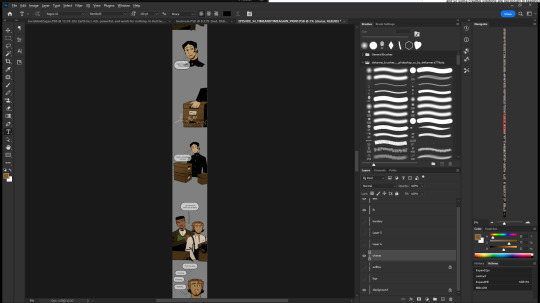
3: I draw one very large (twice as big as any panel would be, minimum) background for my major locations, as well as drawing furniture assets in isolation. This not only saves me time when making my actual episodes, but it also offers me INCREDIBLE flexibility when making this transition to print.
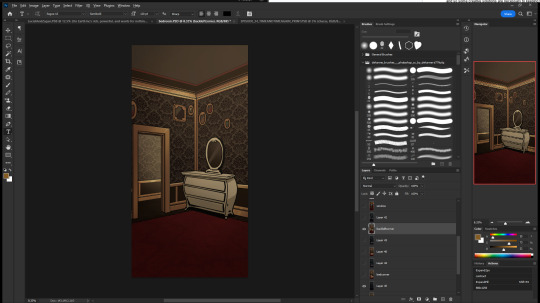
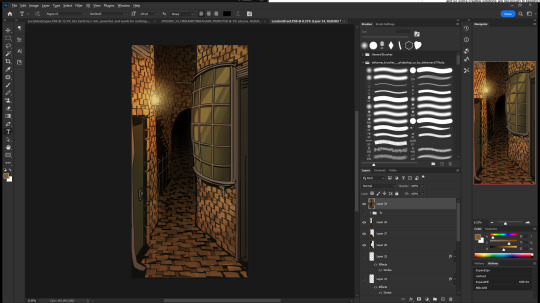

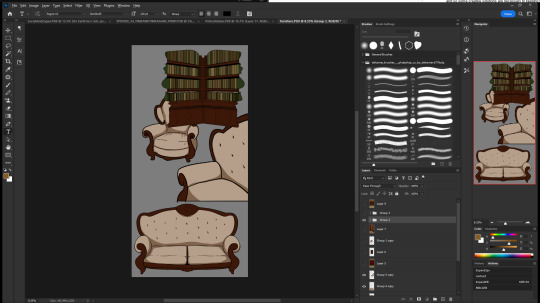
These 3 things let me pull the character art to the page by itself, scale it up or down to fit my panel, and then fill in the background behind the character.
So, I read the scroll version, decide how many and which panels I want on the page for the pacing (I also keep page spreads and page turns in mind while I am doing this), and then I pull those panels over from the scroll version to the page.
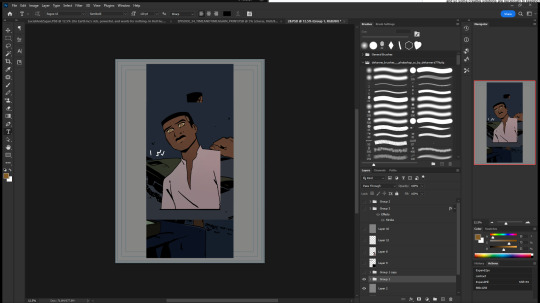
Then, I make the panel borders/page layout that I want, fit the character art into it, paste in the backgrounds, do any art editing that I need, add FX, and then re-do the text!
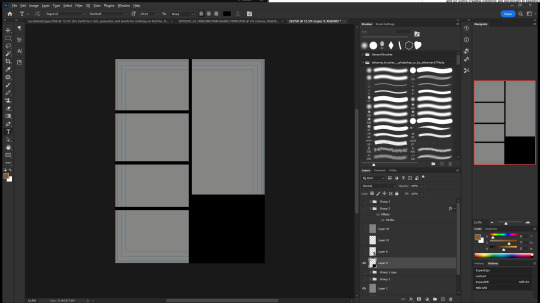
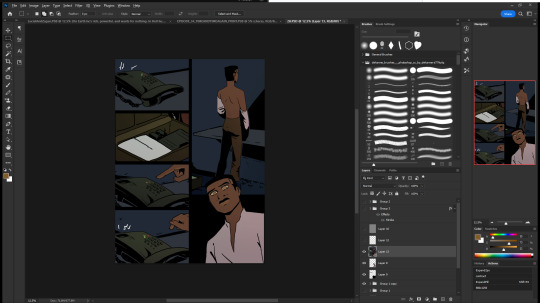
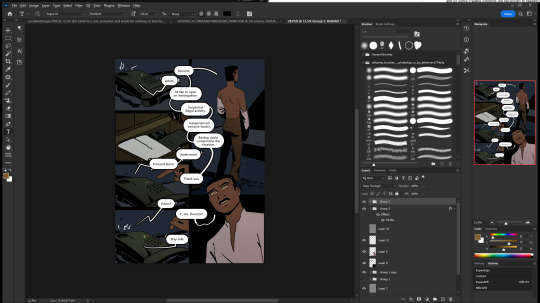
Sometimes I do need to draw parts that are missing (shoulders or elbows getting cut off is an extremely common one) and sometimes I need to adjust facial expressions, cut panels, or rearrange panels to make things read more clearly. Since it's my comic already, I know how to do these things while maintaining the original intent, but if I were working with someone else's comic I would need to work closely with them to know what can and can't be cut.
(original panel vs an expanded version)
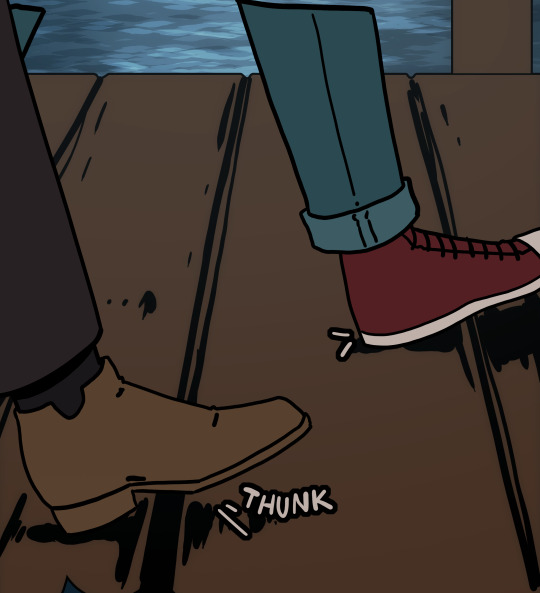
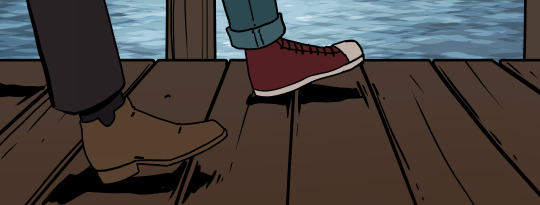
Another common issue is that VERY tall panels will inevitably lose a lot of information when they’re turned to pages. Identify the purpose of the panel (pacing, showing a lot of detail, etc) and then replicate that with your page layout.
examples (in order) are: scene transition, being overwhelmed, suspense, and establishing shot. All of these were a single panel in the scroll version!


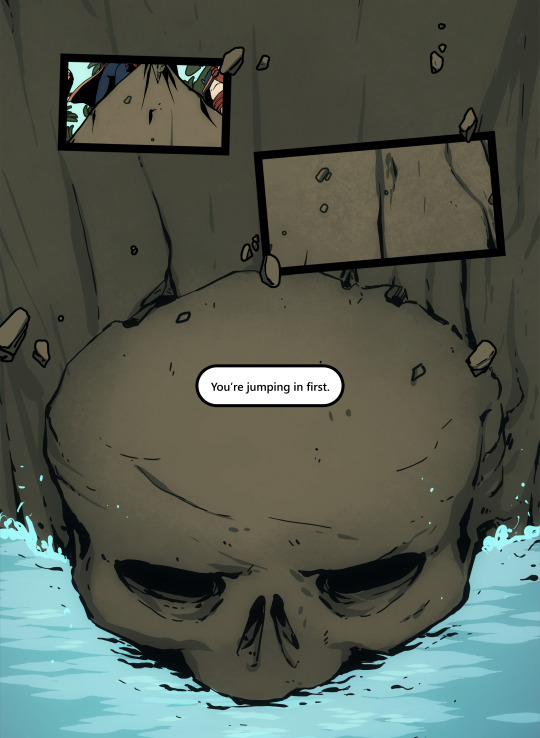
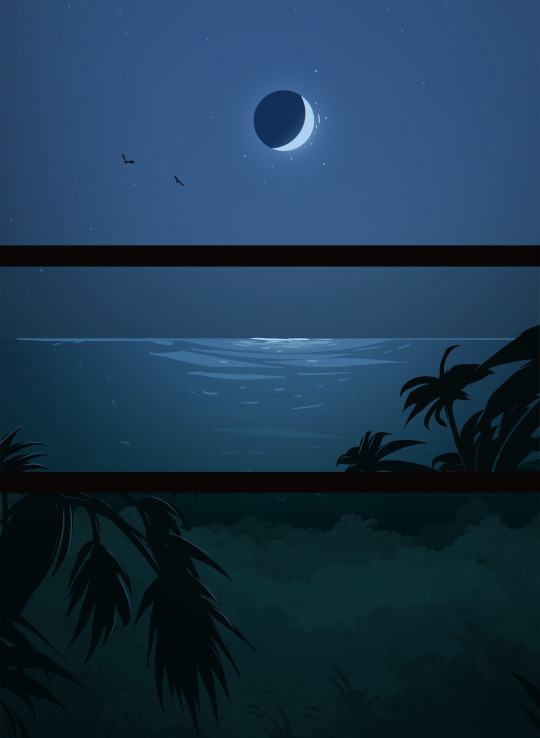
Another issue when converting pages is that panel order is a lot less straightforward than when starting from print format. Conversational back and forth that's fine in scroll often messes up the flow of reading in a page (characters facing out, not looking at eachother from panel to panel, etc) and so some creative solutions are necessary to keeping the reading order.
For the first page I had to delete and rearrange some panels, and in the second the dialogue bubbles guide us to read this page in a circle. (dialogue guides through a lot of my pages lol)
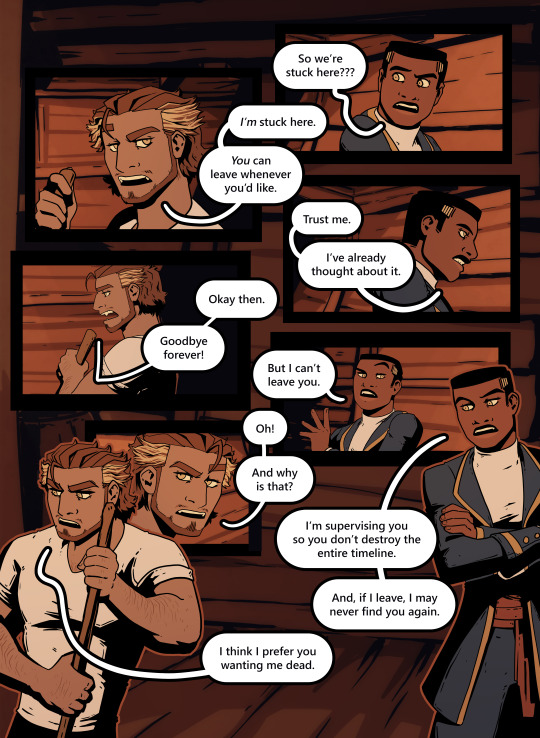

And the last really common issue that pops up is that height differences can be really difficult. Usually in print this is solved with clever angles, but I’ve already drawn everything. So, I’ll either resort to vertical shaped panels, panel pop-outs, or editing a character up or down to fit into the panel.
(examples in order)
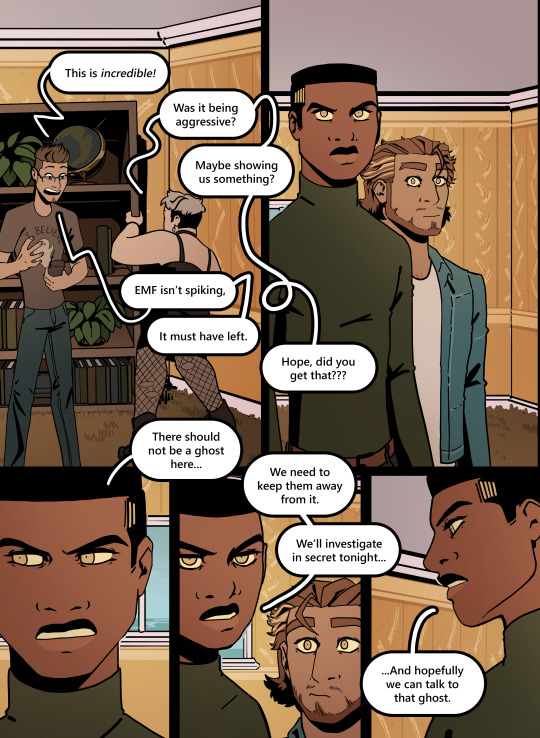
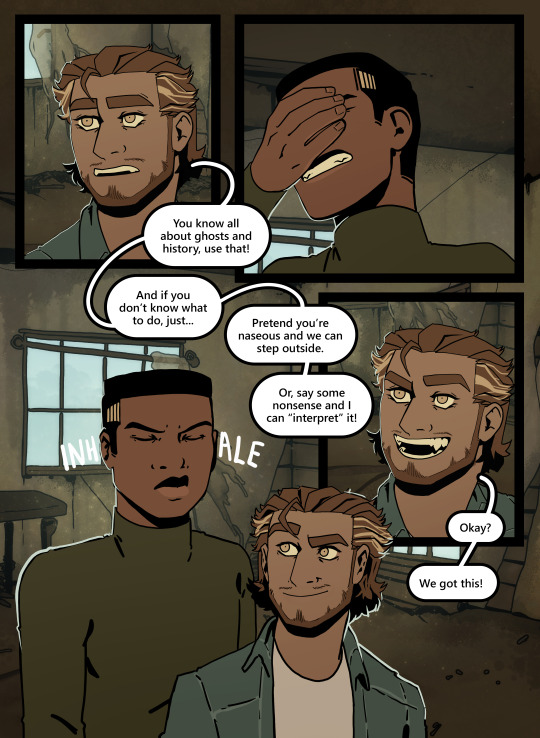
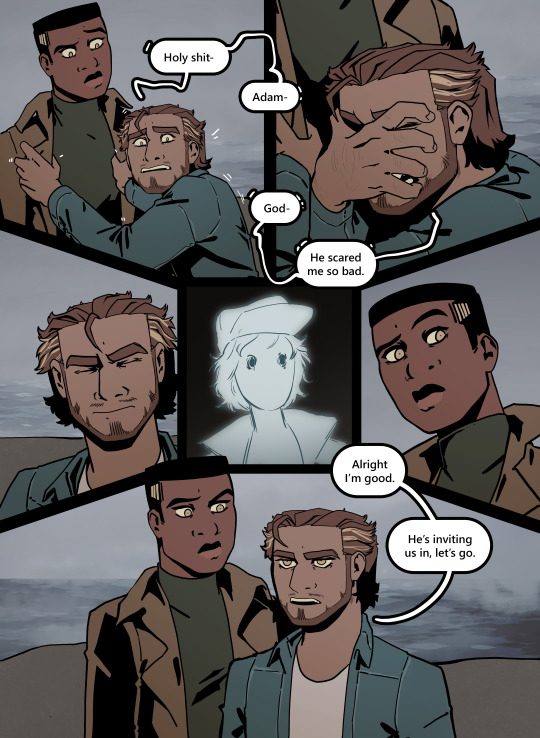
So, yes, it is difficult! But I have a lot of experience with both formats, and having prepared for this from the beginning I've been able to make the transition a LOT more smoothly than I otherwise could have.
I hope this helps!
And, thank you about the kickstarter! I'm extremely excited I'll be able to print these, the proofs I've received so far look just absolutely stunning and I'm so so so excited to get to send them to people!!!
Obligatory self promo, if you want to see the kickstarter page and get these four books for yourself, then you can check it out here ^^ It's been funded, so at this point we're just reaching stretch goals and placing orders!
#asks#anon#art tips#comic tips#web comics#comic books#comic advice#also this is just my own experience obviously everyone works differently and I cant promise this will work for you too#but doing things this way I've been able to finish about an episode (15 pages or so) every day#so it's been extremely swift (though also of course a ton of work)#thank you past me for making this so easy!!!#it'd easily take 5x as long without the prep I did!!!
190 notes
·
View notes
Text
Five Pebbles Artificer Pearl Rewrites (Part 2)
Part 1
And I continue onwards...
Original pearl dialogue can be read here for comparison
Sky islands 2
This is a log of a Sliverist conversation group. Some of the replies are mine.
I don’t imagine you would have any understanding of who Sliver of Straw is. This is something privy to us iterators, and meaningless to beasts like you.
She is one of a few who has been confirmed dead. Our creators had taken great measures to prevent this, as my kind are built to endure and last through the worst conditions for agonizingly lengthy periods of time.
No, what makes her stand above the other casualties is the Triple Affirmative. A broadcast that a solution had been found. While initially I had ignored this- as much of the “discussion” leaned towards being aimless and unproductive- the implications soon became obvious.
The Triple Affirmative is not a strict guideline. A problem can have multiple solutions. Perhaps by escaping this maze through death as she did, we can gain a new perspective.
My motivations have been mistaken before, personal ascension and attempting to break taboo is seen as a selfish goal for an iterator. But I won’t bother to correct those bad faith, regressive arguments.
…
Did you even understand any of that?
Farm Arrays - Bright Red
Oh, this is a Small Plate written in an age long before the Void Fluid revolution.
It’s a text for spiritual guidance. It details how to shed oneself of the fourth natural urge, Gluttony, stylized as a poem. Standard for the time.
The natural urges were tricky to define, but my creators had a general understanding. It was the desire to lash out, reproduce, connect, eat, and survive. These are what bind all living organisms to life, including you and I. Though we are vastly different in how we experience such phenomena.
They had tried vigorously to rid of these urges. By disconnecting yourself from bodily wants, you could transcend your mind through realities beyond the material. Or, so they say.
Though myself and my kind cannot ascend through the same means of fasting or drowning in the Void Sea, I believe it can all be stripped down to perception.
But explaining that to you is pointless. You may be intelligent- admittedly more so than I assumed- but your mind could not comprehend this to the same degree I can.
Regardless, thank you. I have a fondness for artifacts such as this.
Farm Arrays - Deep Pink
On regards of the (by spiritual splendor eternally graced) people of the Congregation of Never Dwindling…”
I will spare you what little details are here. The data is an extremely verbose shipment confirmation to an automated farming plot.
Worse enough, the message was burned several thousand over through the lattice, making it essentially useless to recycle for more productive uses.
My creators had a special talent for wasting time.
Subterranean - Teal
It’s a blueprint for the Void Fluid filtration system beneath my facility.
My neighbor to the east of here was connected to an older pipe network that predates my construction. She was later rerouted into sharing my installation.
However, unlike our shared groundwater, nothing of note has come from this. Primarily due to the filter’s rapid decay to uselessness.
The source of the decay was not from water, wind, or fissures, but from the Void Sea- a vast well of the purest Void Fluid, and an entity of unfathomable scale.
Expensive filtration of Void Fluid obtained in upper rock layers is the only way to get pure samples. Any pipes that went further were quickly destroyed by the tidal forces of the abyssal ocean.
I wish I could tell you more, little beast. But those who lived in our lofty cities did not come into contact with the Void Sea themselves, so much of the research available to me is… old, lost, or poorly translated.
The collective ignorance to such an interesting discussion is upsetting, but not new.
Neither of us get the privilege of seeing the elusive substance, thankfully simulations have sufficed for me thus far. Any remaining puddles you might find in my city are going to be more dirt than Void.
Pipeyard - Deep Purple
An automated maintenance and production log from one of the forty-seven drills north of the farm arrays. It’s quite old. Older than my neighbor.
Its age is the only interesting detail about it. Those drills have been offline for a very long time, being replaced by underground systems.
Why it wasn’t demolished or re-integrated is beyond me. Nostalgia, perhaps? Those old mining sites are the remnants of a time of technological revolution! But I know full well they wouldn’t have cared about some rusty drills on the surface.
A petty criticism, but still wasteful. I sincerely hope the bugs are making more use of it than they ever had.
15 notes
·
View notes
Text





Space, the Final Frontier
Ignore the Space Marines and unfinished Rising Freedom in the background, both of those are my brother's.
Here is the 1/2500 Scale USS Enterprise D from Star Trek the Next Generation by Round 2 previously known as AMT.
The box claims that this a no glue, no paint build thanks to this model from the 80s having been modified to be snap fit, printed in a color fitting its base layer, and including an impressive amount of water slide decals. However, it will not be color accurate if you do not paint it, as the nacelles, deflector dish, phaser strips, and a few smaller details will be left in the base plastic color.
Not wanting to invest in a lot of paints yet, I tried to get by using Gundam Markers, mostly the Gundam Seed set and one of the metallic colors as well. Don't do that. It does work, but trying to clean them up or be precise is a hassle. I ended up getting some dollar store brushes and painters tape to compensate, and that helped, but it was still kind of a pain. Everything I read told me that doing something like this with them would be, but I did it anyway just to see for myself.
I also used Mr. Hobby Water Based Matte Top Coat and Tamiya Mark Fit Decal Solution to help apply the water slides and top it all off as well. More details and some process and pre-top coat photos under the cut.
As for the model itself, its gates are huge, you are not going anywhere near this thing with a single blade nipper, and I ended up damaging part of the saucer trying to get the gates off. I should have just got them as close as I could with nippers then sanded the heck outta them.
Also, I assume because this was originally from the 80s that was originally meant to just be painted, the raised details on the model, and the water slides don't actually line up very well a lot of the time. It's not super noticeable except on the bottom of the engineering section where it's just impossible to get the two phaser strips to line up even remotely close to both.










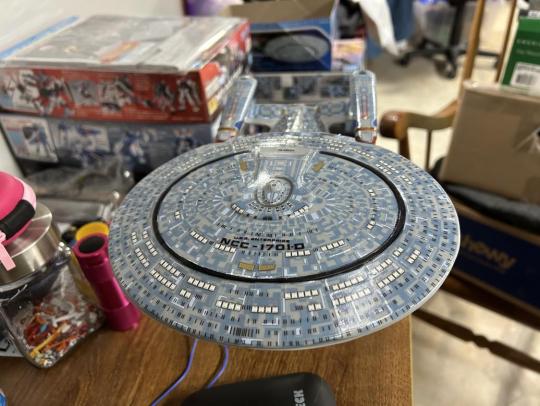
16 notes
·
View notes
Text
Make Sunsets
Experiments with unknown long-term consequences that will impact every living being. When you have people like that, who with money and crazy ideas claim the right to do whatever they want, how can you not worry about these madmen? It was already bad enough with Bill Gates.
1. Is This Initiative a Good Idea?
Potential Benefits : The goal of reflecting sunlight to cool the planet is rooted in observed natural phenomena (e.g., volcanic eruptions temporarily cooling the Earth). If successful, such interventions might reduce global temperatures and buy time to address climate change.
Proponents argue it could mitigate extreme heat, sea-level rise, and other climate impacts.
Major Concerns :
Unintended Consequences : The climate system is highly complex. Sulfate aerosols could disrupt rainfall patterns, worsen droughts, or alter monsoons, disproportionately affecting vulnerable regions.
Moral Hazard : Relying on geoengineering might reduce urgency to cut greenhouse gas emissions, which are the root cause of climate change.
Ethical Issues : Decisions about planetary-scale interventions lack global governance. Who gets to control the "thermostat"? What if some nations suffer harm?
Irreversibility : If deployed at scale and then abruptly stopped ("termination shock"), rapid warming could occur, causing catastrophic ecological and societal disruption.
2. Bad Consequences of Sulfur Dioxide Injection
Acid Rain : Sulfur dioxide oxidizes into sulfuric acid, which can fall as acid rain, damaging ecosystems, agriculture, and infrastructure. While stratospheric injection delays this (particles stay aloft longer), they eventually descend.
Ozone Depletion : Sulfate aerosols can accelerate ozone layer destruction, increasing UV radiation risks.
Health Risks : If particles reach ground level, sulfur dioxide irritates lungs and exacerbates respiratory diseases.
Geopolitical Conflict : Countries affected by unintended consequences (e.g., crop failures) could blame the actors deploying geoengineering, leading to conflict.
Ecosystem Disruption : Changes in sunlight and precipitation could destabilize ecosystems, affecting biodiversity and food chains.
3. Will the Sulfuric Acid "Fall Back to Earth"?
Yes, but not immediately. Stratospheric particles can remain aloft for 1–2 years, slowly descending due to gravity and atmospheric circulation. When they reach the lower atmosphere, they may contribute to acid rain or soil/water acidification. While the concentration per unit area would be low, the cumulative global impact is uncertain.
Key Criticisms of the Initiative
Premature Deployment : Small startups like Make Sunsets are experimenting without robust scientific consensus, regulatory frameworks, or transparency.
False Equivalence to CO₂ Emissions : While CO₂ drives long-term warming, sulfur dioxide’s effects are short-term and come with distinct risks. Comparing the two oversimplifies the trade-offs.
Ethical Overreach : The CEO’s claim that it’s "morally wrong not to do this" ignores the precautionary principle. Unproven interventions could cause more harm than good.
Conclusion
While geoengineering research has a place in climate discussions, rushed, unregulated deployment is reckless . The risks of sulfur dioxide injection—including acid rain, geopolitical strife, and ecological harm—currently outweigh the hypothetical benefits. Climate solutions should prioritize rapid emissions cuts, renewable energy, and adaptation. Geoengineering should remain a last-resort option, subject to rigorous international oversight.
The initiative described reflects a dangerous "technofix" mindset, sidestepping systemic change in favor of unproven, high-stakes experiments. As climate scientist Raymond Pierrehumbert warns: "Geoengineering is like chemotherapy for the planet—it’s not something you do unless you’re very, very sick." We’re not there yet—and we must act to ensure we never need to be.
#Make Sunsets#climate change#geoengineering#republicans#maga#donald trump#jd vance#robert kennedy jr#tulsi gabbard#joe biden#kamala harris#democrats#bill gates
7 notes
·
View notes
Text
The Future of Cryptocurrency: Trends and Innovations to Watch
Cryptocurrency has evolved from a niche technology into a global financial powerhouse. With major institutions, governments, and retail investors now taking digital assets seriously, the future of crypto is more promising than ever. As we look ahead, here are some key trends and innovations shaping the future of cryptocurrency.

1. Institutional Adoption
One of the most significant changes in the crypto landscape is the growing interest from institutional investors. Companies like Tesla, MicroStrategy, and even traditional banks are now holding Bitcoin and other digital assets on their balance sheets. This growing adoption will likely drive more stability and legitimacy in the market.
2. Central Bank Digital Currencies (CBDCs)
Governments worldwide are exploring Central Bank Digital Currencies (CBDCs) to modernize their financial systems. Countries like China, the U.S., and the European Union are working on their own digital currencies, aiming to offer a secure, government-backed alternative to decentralized cryptocurrencies.
3. Decentralized Finance (DeFi) Expansion
DeFi platforms have revolutionized the financial industry by offering decentralized lending, borrowing, and trading without intermediaries. The rapid growth of DeFi projects suggests that traditional banking could soon face stiff competition from blockchain-based alternatives.
4. Layer 2 Scaling Solutions
One of the biggest challenges facing blockchain networks like Ethereum is scalability. Layer 2 solutions, such as the Lightning Network for Bitcoin and Optimistic Rollups for Ethereum, are designed to reduce transaction fees and improve processing speeds. These advancements will make crypto more accessible and practical for everyday use.
5. NFTs and the Metaverse
Non-Fungible Tokens (NFTs) have transformed digital ownership, impacting art, gaming, and virtual real estate. The integration of NFTs with the metaverse—a digital universe where users interact in virtual spaces—will open new opportunities for creators, businesses, and investors.
6. Regulatory Developments
As crypto adoption grows, governments are working on regulatory frameworks to ensure security and compliance. While some regulations could pose challenges, they could also provide greater legitimacy, attracting more mainstream users and institutions.
7. Sustainable Crypto Mining
The environmental impact of cryptocurrency mining has been a concern, leading to the rise of eco-friendly mining solutions. Innovations such as proof-of-stake (PoS) consensus mechanisms, renewable energy mining, and carbon offset initiatives are helping reduce crypto’s carbon footprint.
Final Thoughts
The cryptocurrency industry is constantly evolving, driven by innovation and adoption. Whether it’s institutional interest, DeFi growth, or the rise of NFTs, the future of crypto looks bright. However, investors should remain informed and cautious as regulatory changes and technological advancements continue to shape the market.
3 notes
·
View notes
Text
9/22 - 9/29/2024
Aaaaand several months later, Renji 11 is complete (again).
Which brings me to a couple additional milestones:
1) I finished a full draft of my banner!

My idea here is that each chapter would get some little icon that relates to something about the chapter, as well as the narrating POV's division flower. I'm trying to decide whether it matters if the item is, uh, legible. That's supposed to be a baggie of manju but they kind of look like tomatoes. Is it weird that the two images are totally different line weights? And even if it is, do I trust myself to draw 20 different glyphs with the same line weight?? The stamp effect/weathering could probably be more intentional--for now I quickly took a dry media brush to a Layer Mask to see if it could effect what I wanted. It's because I am bothered by the vector-smoothness of the weathering in the font itself when the text is that large.
Apparently I did the low-res mockup for this on December 14, 2023, so at least it's been less than a year?! It also means that I've continued to like this design, even after 10 months. (Here's the partial V2 I didn't move forward with.)
2) It's my first time in the six-figure club! Which is impressive to me, because I don't generally consider myself a longfic person, and I've never written a singular fic of this scale before, for any fandom.

At this point, this project is causing me a lot of cognitive dissonance, ngl. Because this fic represents the majority of my Bleach fandom experience (I've been working on it since 2021, and it's the sequel to my first two Bleach fics, which I wrote before we made this blog). In my mind, it basically IS my Bleach identity. But it's not meaningfully reflected in this blog, which is... well, it's us? B3 IS our Bleach identity? Not that our original posts are what the majority of people follow this blog for, but still. What an identity crisis!
The obvious solution is to post it, and I do feel like I've moved on emotionally enough from Part 1 that I could probably survive that! But I also kind of feel like, don't I already have plenty of things to survive right now? 🫠
--
I'm undecided on what I want to tackle next. I'd like to finish my revision round for Rukia 7 / Rukia 10 / Renji 11, but that's the kind of thing that requires more unbroken time, and that does not really work with my current "oh god 10 minutes, GO" state of being. So I feel like if I want to try that, I also need an additional place where all I need to do is drop in and write lines. They can't be in Hitsugaya 12, though, because I've written as much of that as I can without knowing how the Hisagi 9 revisions pan out.
I have distinct memories of having very pleasant daydreams about how those revisions should go (very specifically on US 127, in weather non-conducive to daydreaming), but I looked over those scenes last night and HAHAHA. I HOPE I WROTE NOTES FOR THOSE DAYDREAMS because while I do remember writing them as written, I do not have any distinct memories about how they needed to be changed, rip
8 notes
·
View notes
Text
A Complete Guide to Ethereum Layer 2 Scaling Solutions
As Ethereum continues to grow in popularity and adoption, scalability has become a pressing issue. With network congestion and high gas fees hindering user experience and limiting the platform's potential, solutions are urgently needed. Enter Layer 2 scaling solutions – a set of techniques designed to increase Ethereum's transaction throughput while maintaining its security and decentralization. In this blog post, we'll delve into the basics of Ethereum Layer 2 scaling solutions, exploring what they are, why they're essential, and how they work.
What are Layer 2 Scaling Solutions?
Layer 2 scaling solutions are protocols and technologies built on top of the Ethereum blockchain that aim to increase its transaction capacity without altering the underlying consensus mechanism. These solutions operate "off-chain," meaning transactions are processed outside the main Ethereum network, reducing congestion and lowering transaction costs.
The Need for Scalability
Scalability is one of the most significant challenges facing Ethereum today. As the number of users and transactions on the network continues to rise, congestion becomes more prevalent, leading to slower confirmation times and skyrocketing gas fees. Layer 2 scaling solutions address these issues by offloading transactions from the main chain, improving overall throughput and scalability.
Types of Layer 2 Scaling Solutions
There are several types of Layer 2 scaling solutions, each employing different techniques to enhance Ethereum's scalability. These include:
Sidechains: Sidechains are independent blockchains that run parallel to the Ethereum main chain. By moving transactions off-chain and processing them on a separate network, sidechains can increase transaction throughput and reduce congestion on the main Ethereum network.
State Channels: State channels allow users to conduct off-chain transactions directly with each other, only settling the final state on the Ethereum main chain. This enables instant, low-cost transactions without the need for on-chain confirmation for every transaction.
Plasma: Plasma is a framework for building scalable applications on Ethereum by creating nested blockchains (child chains) that periodically commit their state to the Ethereum main chain. Plasma chains can process a high volume of transactions off-chain while maintaining the security guarantees of the main chain.
Rollups: Rollups are Layer 2 scaling solutions that bundle multiple transactions into a single batch and then submit a single transaction to the Ethereum main chain. This significantly reduces the number of on-chain transactions required, improving scalability and reducing gas fees.
How do Layer 2 Scaling Solutions Work?
Layer 2 solutions for ethereum work by moving some or all of the transaction processing off-chain, thereby reducing the burden on the Ethereum main chain. Transactions are executed and verified off-chain using various techniques such as state channels, sidechains, or plasma chains. Once complete, the final state is settled on the Ethereum main chain, ensuring security and decentralization.
Conclusion: In conclusion, Ethereum Layer 2 scaling solutions offer a promising path forward to address the platform's scalability challenges. By moving transactions off-chain and employing innovative techniques such as state channels, sidechains, plasma, and rollups, these solutions can significantly increase Ethereum's transaction throughput while reducing congestion and gas fees. As Ethereum continues to evolve, Layer 2 scaling solutions will play a crucial role in unlocking its full potential and enabling widespread adoption.
1 note
·
View note
Text
Solieum Emerges as Solana’s Next-Gen Layer 2 Solution, Promising Unmatched Speed and Scale
The Solana ecosystem is on the cusp of a transformative leap forward with the upcoming launch of Solieum, a cutting-edge Layer 2 protocol designed to supercharge the blockchain’s already impressive performance. Positioned to address Solana’s scalability challenges during peak demand, Solieum is generating buzz in the crypto community as a game-changer for decentralized finance (DeFi), gaming, and Web3 applications.
A Response to Solana’s Growing Pains
Solana has long been celebrated for its high throughput and low-cost transactions, processing thousands of transactions per second and boasting a total value locked (TVL) of $10.9 billion, surpassing the entire Ethereum Layer 2 ecosystem. However, as the network’s popularity has surged — fueled by meme coins, DeFi projects, and platforms like Pump.fun — congestion during high-traffic periods has exposed scalability limitations, leading to delays and occasional downtime.
Solieum steps into this gap as Solana’s next-generation Layer 2 solution, engineered to enhance the network’s endurance without compromising its core strengths: speed, affordability, and user experience. Unlike Ethereum’s Layer 2s, which primarily address high gas fees, Solieum focuses on managing Solana’s growing waves of activity, ensuring seamless performance under real-world pressure.
What is Solieum?
Solieum is a Layer 2 protocol built to elevate Solana’s capabilities by processing transactions off-chain before committing them to the main network. This approach reduces congestion, lowers fees, and minimizes downtime, making it ideal for high-volume use cases like DeFi, GameFi, and meme coin trading. By leveraging advanced technologies, Solieum aims to deliver:
Infinite Scalability: Handling massive transaction volumes without sacrificing speed.
Zero Downtime: Ensuring continuous operation, even during network stress.
Multi-Chain Interoperability: Operating across Solana and potentially Ethereum, adding a layer of utility for developers and users.
The project’s whitepaper, set to be released soon, promises to outline a roadmap for redefining Solana’s edge in the blockchain space. According to recent posts on X, Solieum is “forged to disrupt limits” and is poised to “rewrite the rules” of Layer 2 solutions.
Momentum Building Ahead of Launch
Solieum’s pre-launch buzz is palpable, with the project nearing its debut. The crypto community is closely watching as Solieum prepares to unveil its infrastructure, which includes a block explorer to boost transparency and long-term upgrades for scalability and network incentives.
Recent posts on X highlight Solieum’s ambition to “unlock a brighter, faster blockchain era” and position it as a cornerstone of the Web3 landscape. The project’s focus on speed, scale, and innovation has drawn comparisons to other Layer 2 solutions like Solaxy, which raised over $34 million in its presale, signaling strong investor confidence in Solana-based scaling solutions.
Why Solieum Matters
As Solana continues to outperform competitors in DeFi metrics — generating $50 million in weekly dApp revenue and eyeing a price target of $300 — its need for robust scaling solutions has never been more critical. Solieum’s arrival could solidify Solana’s position as a leading blockchain for developers and users, particularly in high-throughput sectors.
By addressing network bottlenecks and enhancing interoperability, Solieum is poised to attract developers building next-gen dApps and investors seeking exposure to Solana’s growth. Its multi-chain approach also opens doors for cross-ecosystem collaboration, potentially bridging Solana and Ethereum communities.
Looking Ahead
With its launch on the horizon, Solieum is shaping up to be a pivotal development for Solana’s ecosystem. The project’s emphasis on scalability, reliability, and innovation aligns with the broader trend of Layer 2 solutions driving blockchain adoption. As the whitepaper drop and launch approach, all eyes are on Solieum to deliver on its promise of a “faster, smarter decentralized future.”
For those eager to stay updated, Solieum’s official channels on X and its website (solieum.com) offer the latest insights into its progress. As the countdown to launch continues, Solieum is ready to make waves in the blockchain world, proving that Solana’s best days are yet to come.
Disclaimer: This article is for informational purposes only and does not constitute investment advice. Cryptocurrency investments carry high risks, and readers should conduct their own research before participating in any project.
#solana#binance#crypto#blockchain#bitcoin#eth#dogecoin#cryptonews#altcoin#digitalcurrency#cryptocurrency
2 notes
·
View notes
Text

So, it turns out, drawing planets is hard....
Anyway, here is the system we will be following as life develops on multiple planets, with the sizes to scale, but the distances obviously not! The system is shown as it would appear 5 billion years into its history. Tidally locked planets are shown with their sub-stellar point pointing at the observer.
Lets start with the star, the energy source for the entire show. Yggdrasil (Norse tree of life, and foundation of the universe) is an M1V BY Dra star, which when translated to English means that the star is a large red dwarf (nearly at the limit of M class), but it is also a BY Draconis variable, meaning that its starspots are so big, that they can significantly reduce it's light output. This star is expected to have a main sequence lifespan of 225 billion years, but as with all red dwarfs, its luminosity will increase significantly more proportionally than Sol's will, so its habitable zone will end covering most of its terrestrial planets for at least some part of it's lifespan.
Hephaestus (Roman god of fire and the forge) and Laki (named after a particularly destructive Icelandic volcano) are the two innermost planets of Yggdrasil. They are both hot, small worlds with large iron cores, similar (though smaller and a little cooler) to Mercury. By 5 billion years into the systems history, Hephaestus's mantle has cooled and solidified, but Laki alternates between a resonance state with Vitrellus and one with Thalia, meaning that it maintains a constant volcanic output driven by tidal forces, even though a planet of it's size should have no primordial heat left. Laki was on the cusp of habitability, but it's high volcanism resulted in a runaway greenhouse event that stripped it of its water early in it's history, leaving it with a roughly 2 bar atmosphere of CO2 and SO2.
Methuselah (named for the biblical patriarch, said to have lived for 969 years) is our next stop, and unlike Laki this world is the first one to be able to hold onto significant water. However, due to it's proximity to Yggdrasil, its water cycle is very different to Earth. At it's equator, it is too hot for rain to reach the ground, and so it's tropics and mid latitudes are parched deserts with only very rare oasis providing any moisture. At the poles, however, water can condense, and these small seas provide Methuselah with 2 very habitable areas for life. Methuselah is a small planet, twice Mars's mass but much smaller than Earth, but it is locked into a complicated resonance with Thalia and Avalon/Eden, one which will remain indefinitely, and means that Methuselah is capable of sustaining plate tectonics despite it's small size.
Vitrellus (named in reference to Oil of Vitriol, an old name for sulphuric acid) is the most alien of all the worlds in the Yggdrasil system. This world, half the mass of the Earth and nearly the same radius, has a much higher concentration of sulphur and sulphur compounds in its crust, meaning that it's oceans condensed not as water, but as a strong solution of sulphuric acid. Despite this incredibly hostile chemistry and hellish temperatures (regularly reaching 90 degrees Celsius at the equator), Vitrellus has an active and diverse biosphere based on silicon, carbon, and sulphur compounds.
Thalia (named for the Greek Charity of fertility and plants) is a planet somewhat larger then Earth, which due to it's size accreted a large envelope of volatiles onto its surface, forming an ocean nearly 50km deep on average. This layer of volatiles also created a thick atmosphere and a strong greenhouse effect, creating surface temperatures just barely below the critical point of water, where the boundary between the ocean and atmosphere becomes indistinct. No life survives down there, but the cloudtops maintain habitable temperatures despite the torrid conditions below, allowing huge blooms of skyplankton and other attendant organisms to flourish, turning the planet a strong green colour.
Dionysus (named for the Greek god of festivity and insanity) is the closest thing to the traditional picture of a tidally locked world orbiting a red dwarf that Yggdrasil has to offer. It has the traditional swirl of cloud surrounding it's sub stellar point, and at this point in it's history an ice sheet surrounding it's terminator. The planet currently has an active surface biosphere, but this is only a temporary feature. Dionysus goes through regular cycles of huge build ups of carbon dioxide in it's atmosphere, up to 1-2 bar, followed by equally massive drops in CO2 levels down to just a few parts per million, caused by continents passing through it's central collection of storms. Life on Dionysus is one of times of huge plenty, and vast catastrophes.
Avalon/Eden are the jewels of the Yggdrasil system, a pair of habitable superearths locked in orbit of each other. Both of these worlds are ideal candidates for life; large mineral rich oceans, plate tectonics to allow for carbon cycling, and their mutual tidal forces will keep their interiors warm and convecting for billions of years. There is one current difference between themselves and Earth, however; as these planets are currently towards the outer edge of the habitable zone, they have large CO2 dominated atmospheres, nearly 2 bar each, just to keep warm. These planets will be the centre of attention for this project, and along with Methuselah, will maintain life for the longest time.
After the Avalon/Eden system is a rocky asteroid belt, containing twice the mass of Sol's asteroid belt, followed by an interloper from the outer reached of the system. Anguta (named for the Inuit creator god, and god of the underworld) is a waterworld that initially formed outside of the gas giants in the system, before an encounter with Persephone saw it swing into the inner system. A combination of another encounter with Parvati, and drag from the original system asteroid belt (now carved in 2 by Anguta), caused it to settle into a circular orbit. Anguta is currently right at the outer edge of the habitable zone, with it's surface locked in ice and only a thin, nitrogen dominated atmosphere, but as Yggdrasil grows in luminosity, this is unlikely to last.
Our next stop is the queen of the system, the largest planet of Yggdrasil, Parvati (Hindi goddess of power and beauty). Parvati is a large gas giant, 50% more massive than Jupiter, with a large collection of rocky and icy moons, and rings to rival Saturn's.
Odin (Norse god of wisdom and healing) is the second gas giant of the system. It is about half the mass of Jupiter, but due to the effect of gravitational compression, Parvati and Odin are almost the same size, to within a few dozen kilometers. Odin has a thin set of rings, but has 4 major moons locked into a Laplacian resonance.
Amun (Egyptian god of the sky and wind) is the systems only ice giant, an azure gem shining brightly due to methane in it's atmosphere granting it a brilliant blue colour. Occasional clouds of methane occur in it's mid latitudes, and around storms in it's tropics.
Persephone is the final planet, an Eris like object in it's outer system, covered in a homogeneous layer of ice that was deposited from past volcanic paroxysms.
45 notes
·
View notes
Text
Excerpt from the above link:
First thing’s first. If the phrasing in the title feels unfamiliar, it has a purpose: We are eliminating the passive voice from the pandemic. Right now.
Someone INFECTED Neil Gaiman with COVID-19.
And many someones in overlapping layers of responsibility ENABLED this infection.
This linguistic shift from the passive to active voice might seem irrelevant but, instead of just echoing the framing we see in the headlines — that Neil Gaiman got COVID-19— it’s time to own that somebody has infected Neil.
The passive voice has served a macabre purpose in this pandemic. The passive voice, by erasing the subject of the sentence, neatly obscures accountability, and with it our own role in unmitigated infections. Moreover, it has prevented us from identifying the layers of responsibility in enabling infections on a mass scale. This mental block is the first obstacle to advocating for effective mitigations and constructive solutions. It stops us from preventing infections. But that is changing now.
It is time to own the damage that we are causing by infecting others with COVID-19. I believe that we all know, deep inside, that we are causing harm. And many of us are suffering from the cognitive dissonance of pretending that we aren’t. Because, in a pandemic, this is serious and large-scale harm.
This harm that, according to estimates, has killed over 25 million people and disabled at least 65 million and counting. The sooner we face the harm we are causing by infecting other people, the less damage we will cause to ourselves, to our loved ones, to our community, to strangers on the other side of the world. And to people who entertain and inspire us, like speculative fiction author and TV creator Neil Gaiman. And inspiration is necessary when we are facing so many challenges. It’s that simple.
COVID-19 is a serious, multi-system vascular disease that creates severe and cumulative damage.
Reinfections tend to be more severe and Long COVID occurs in 1/10–1/3 infections.
Up to 60% of infections are spread asymptomatically… Wait, let me rephrase that. People, who are asymptomatic, or presymptomatic, are infecting others with COVID-19 in up to 60% of cases.
A person who is presymptomatic can transmit a COVID-19 infection up to two days before symptoms arise.
People infect other people with SARS-CoV-2 through aerosols. An infected person expels them just by exhaling. The aerosols accumulate in the air, and spread across large spaces like cigarette smoke. They also remain in the air for hours, so even if a room is empty, if a symptomatic person was there earlier, the aerosols will still be there. Crowded, indoor spaces are high-risk for transmission.
We are currently in a wave caused by a new variant for which a vaccine has yet to be developed. In a crowd of 100, statistically 1-2 people will have active infections.
If we put all of this together, we see that live events in crowded, indoor spaces are particularly dangerous, and that masking only when someone is symptomatic is woefully inadequate to prevent infecting others. So, in order to not infect other people, we need to individually mask at these events, and to collectively apply pressure to venues that are enabling these infections, as well as to lawmakers who have removed protections.
That’s the tl;dr. Now, if you have some time, and feel motivated to prevent further infections, let’s look more systematically at the problem of people infecting other people, especially at live events, and how to constructively address it.
Neil Gaiman requested masking at his events, from both venues and audience members
It’s fucked-up that, three days after Neil Gaiman requested that attendees voluntarily mask at his tour events — because the venues themselves refused to enforce audience masking — Neil announced on social media that he has another COVID-19 infection and “this time it means business.”
This infection — and any COVID-19 infection — is terrible, but unfortunately not surprising. We are in a wave caused by multiple variants, and lawmakers worldwide dropped most COVID-19 public health mitigations earlier this year. So people who are appearing at live events now are at an incredibly high risk of being infected. The risk is also increased due to a swarm of new variants — so many versions of the virus are circulating now, you can get a case in August and another in September
As a fan of Neil Gaiman, I guess I wished that somehow it would miss him. COVID-19 infects the brain, and his brain has created my favorite TV series, Good Omens, a queer love story between an angel and a demon. This series has helped me, and countless others, heal from religious trauma. It also rekindled my appreciation for David Tennant in his role as the demon Crowley, who witnesses everything from Old Testament atrocities to a modern-day armageddon, and seems to be the only one suggesting that God might be a tyrant. With so many of us experiencing a dark night of the soul in the pandemic, it’s much-needed validation.
What also worries, but not surprises, me about Neil’s infection is that, if his statement that “this time it means business” is anything to go by, (especially for someone who can be quite understated), this infection is more severe than any previous ones. This unfortunately is also not surprising, as reinfections tend to be more severe. The damage from these infections is cumulative, and SARS-CoV-2 attacks the immune system, in many cases after a person has recovered from an initial infection. Viral reservoirs continually attacking the body are believed to be the mechanism of Long COVID. However, his more severe course reminds me of other performers who are currently touring, almost without exception at massive, indoor, unmasked events.
Actually, it’s more accurate to say that it scares the hell out of me.
Actors from another TV series beloved by queer fans, Our Flag Means Death, including Rhys Darby, Vico Ortiz and Samson Kayo, will appear at London Comic Con on October 27–29th. The event will have more than 100,000 attendees and does not require masks. And David Tennant, who sparked my motivation to advocate for safer venues, will appear at New York Comic Con October 12-15th. NYCC will have over 200,000 attendees and also does not require masks. I checked.
The math on the likely damage is pretty fucking grim.
It’s estimated that in a crowd of 100, 1–2 people have a COVID-19 infection. So that’s at least 2,000 attendees spreading the virus.
Each person infects 2–3 other people. This is total, so they may not infect people at this event. But because the venue is extremely high risk: indoors, crowded, no mitigations, they may infect more people than averge.
So, from 2,000 people who go to Comic Con with infections, that’s at least 4,000 people that they will infect.
Between ⅓–1/10 infections result in Long COVID, so at least 400 people statistically may develop Long COVID. From one event.
tl;dr 200,000 attendees/100= 2,000 infections x 2= 4,000 newly infected/10 =400 Long COVID cases
And that’s the conservative estimate. The upper-end estimate, based on data, is up to 2%.
You can bet that I’m well-aware that David Tennant has a .2%-2% chance of developing Long COVID from this one event, especially because he’s due to play MacBeth in London this winter. The luckiest person who ever existed would statistically develop Long COVID after their 50th event.
It’s not just headlining performers who need to worry about infections. Any attendee has a .2% chance of developing Long COVID from this one event, and that’s a tragedy in the fan community, but also for people working on staff who don’t choose to be there. I wonder what would happen if the damage were immediately visible, like setting fire to 400 guests, fans, and staff people at the door. What then?
If you have read my first article sounding the alarm on unprecedented numbers of performers becoming seriously ill and dying in the pandemic, you will know that my own fannish devotion to David Tennant inspired me to advocate for COVID-19 mitigations at venues and nourishes me with the love and compassion to do this work. With Neil Gaiman’s infection, it hits home that everyone who is currently doing live events, particularly large ones with no mitigations, are quite likely going to be infected. And in the fourth year of the pandemic, that means reinfected, which means that, like in Neil’s case, it will probably be more severe.
Performers are just my own corner of advocacy, but we all breathe the same air, so these new infections will affect everyone. And people with disabilities, who work in service and customer-facing jobs, or who have inadequate access to medical care, will be the most vulnerable. But most people now have had at least one infection, so we’re all facing danger here.
This is why I want to prevent people from infecting people at events, and by doing so to raise awareness in the wider public that this is an escalating emergency. And I think it’s achievable.
The first step is identifying the causes, both individual and structural. Then to come up with workable interventions at each point of responsbility.
Individual responsibility: someone infected Neil Gaiman with COVID-19
Preventing infections begins at the individual level. As the founder of #FansMASKUP, which is dedicated to raising awareness in the fan community about masking at live events, my first feeling was rage at the person who infected Neil. The incubation period for COVID-19 varies widely, from 2–14 days, though on average 5–6. So, if Neil developed symptoms on October 5th, it’s possible that someone in the audience on the October 2nd event infected him. And if that person is such a fan of Neil that they paid to see him live, I ask: why didn’t they just wear a mask? But even this is not so simple.
From my conversations with other fans who have been diligent about masking, they sometimes experience harassment, and fear for their safety and mental health. And since so many of us are LGBTQIA+, neurodivergent, BIPOC and/or disabled, we are statistically more vulnerable to people harassing us, or even assaulting us, if we are the only ones masking. So as much as I’d like to judge this person for infecting someone who they admire, I have to admit that safety is too often a real concern for our community.
What can we do on an individual level to promote safer venues?
If we feel sufficient safety to mask at live events, then we should do so.
If we are going with friends, we can encourage them to mask too.
We can connect on social media and find other fans who are attending and mask together.
Heck, if we have a spare $20 (which not all of us do), we can even give out masks at the event so that we’re not the only one.
Aside from fear and social pressure, people may have stopped masking due to exhaustion, despair and misinformation — we MUST start again. Every masked person can break a chain of transmission and save many, many lives. Maybe even Neil Gaiman’s life, and certainly the lives of your loved ones, including fellow fans.
Institutional responsibility: venues are enabling people to infect other people with COVID-19
It would be a mistake to lay all of the responsibility on the person who infected Neil. There has been systemic neglect, and even malfeasance, at every level of responsibility, and the people who are making these decisions are enabling people to infect others. Though this reaches into the level of policy, let’s begin with the most direct enabler in this instance: the venues.
Remember, Neil said on social media that he requested audience masking at venues, but they refused. Then after his first tour date, he announced that someone had infected with with SARS-CoV-2. We can’t know whether someone infected him at this particular event, though the timing is consistent with the virus’s incubation period. Regardless, the venue has approximately 1,700 seats, and if Neil’s event was sold-out, as most are, that’s: 17 active infections, 51 new infections, 5 cases of Long COVID. So wherever someone infected Neil with COVID, it is worthwhile to advocate for venues to use mitigations.
The mitigations required to significantly reduce people infecting other people at live events are relatively simple and have been proven time-and-again to reduce the the transmission of SARS-CoV-2:
Audience masking and vaccination
Making use of HEPA air purification/filtration.
This is achievable, and venues should have been doing this since 2020. Some venues do it, and it is certainly possible, and not terribly complicated, for more venues to adopt these simple precautions.
Now, the more complex question is: if it’s so simple, why are venues refusing to use mitigations? Some of it is simply greed. It costs money, though not a lot of money, between £300–600 ($370–740) to purchase a HEPA air filter. And for truly cash-strapped venues, vendors likes Smart Air UK are renting out HEPA air filters for events. So there really is no excuse. For those who are unfamiliar with HEPA, here’s a primer from outreach coordinator (and fan herself) for Smart Air UK, Guilia Villanucci.
I’m quoting at length, but tl;dr: HEPA purifiers can remove more than 99.97% of virus particles from the air, and protecting Neil at one of his events would only have cost between $400-$700. And you can’t put a price on his brain, so…
HEPA stands for “high-efficiency particulate air.” HEPA air purifiers are nothing else than a box with a filter and a fan inside. Researchers agree that, based on their efficiency, air purifiers can remove more than 99.97% of virus particles from the air when used continuously. Now, does this extra layer of protection have to be very expensive? It can be, especially if you look only at brand names without paying attention to the technical specifications. I recommend Smart Air products, partly because I work for Smart Air UK, but mostly because these air purifiers are cheaper than most on the market, are highly efficient, and are pretty quiet. NOTE: If you are a performer based in Chicago, USA, you should check out Clean Air Club, they loan air purifiers at no extra cost to artists and touring musicians. If you are a venue or a performer based in the UK, you can rent air purifiers from us, or purchase them to take them on tour with you, just like singer and songwriter The Anchoress does. An investment of between £300 to £600 will probably be enough to keep performers safer in a venue if you purchase from Smart Air UK.
Again, HEPA air purifiers are effective and affordable and I can only think a noxious mix of greed, inertia and denial are preventing most venues from using this basic precaution.
There may be other financial considerations. Requiring masks could lead to lost revenue as people who refuse to mask will not attend. And, as of yet, venues face no financial liability for enabling infections. Though with lawsuits winding their way through courts regarding liability for COVID-19 infections, this may change.
However, like fans, venues may also have legitimate concerns for safety, The far-right has so politicized masking that the people responsible for venues are likely afraid of repercussions, ranging from the awkwardness of barring an unmasked person from attending an event, to someone throwing a brick through the window, or even assaulting a person on staff. These fears are not entirely unreasonable. But we need to make clear that these venues are enabling people to infect their headliners, Neil Gaiman or David Tennent or Taylor Swift. Additionally, lack of mitigations endangers attendees and people on staff, and lawsuits against employers who have exposed employees to COVID-19 infection have had more success. This changes the risk calculation.
What can we do to encourage venues to create safer event spaces?
We can contact the venues themselves, beginning with the ones who likely are not using basic mitigations. These can be any venue where you or one of your favorites will be in attendance.
We can also start with the venues where Neil was scheduled to appear. Here is a list of these venues with the ways to contact them.
Emerson Colonial Theatre (888) 616–0272 [email protected] Twitter-X/IG: @BroadwayBoston
The Westport Library (203) 291–4800 Twitter-X/IG: @WestportLibrary
Cooper Union [email protected] (212) 353–4100 Twitter-X/IG: @cooperunion
Peter J Sharp Theatre (212) 864–5400 [email protected] Twitter-X/IG: @SymphonySpace
Dr. Phillips Center for the Performing Arts [email protected] 407.839.0119 @DrPhillipsCtr
Venice Performing Arts Center [email protected] (941) 218–3779
Zoellner Arts Center at Lehigh University 610–758–2787 [email protected] @LehighU @ZoellnerArts
Frikirkjan i Reykvavik+353 552 [email protected] @iclandnoir
Piggott Theatre (British Library) +44 (0)1937 546060 [email protected] Twitter-X/IG: @BritishLibrary
New Jersey Performing Arts Center 1973–642–8989 [email protected] @NJPAC
If, like me, cold-calling gives you anxiety, here’s a script that you could follow:
“Hello, I am calling to ask what COVID-19 mitigations you use. [If they require audience masking and use HEPA air purification, consider thanking them for their conscientiousness. If they do not, you could say:] Neil Gaiman requested COVID mitigations at venues, but now someone has infected him. To prevent infections at your venue, I am requesting that you require audience masking and purchase a HEPA air purification unit. These are proven to significantly reduce COVID transmissions.”
I know, it’s a bit wooden, so feel free to improvise. But remember: please don’t harass these people, because most likely you will be talking to a staff person and not the person who has made the decision not to use mitigations. And if the person answering the phone is on your side, this has a better chance of success.
You can also request mitigations through social media and e-mails, although phone calls bring the most attention. But do what’s at your comfort level. Most of us who are aware of the ongoing pandemic are burnt-out and need to conserve our energy.
To sum-up, we need to hold ourselves and other fans accountable, but they face real risks and cannot be held wholly responsible. Same for venues. We need to apply pressure for them to adopt COVID-19 mitigations, but they are not wholly responsible. This brings us to the final level of accountability for people infecting other people with COVID-19.
Structural responsibility: governments are enabling infections by eliminating COVID-19 protections
The highest level of responsibility falls to governments, generally, and public health authorities specifically. It’s alarming how quickly people have reverted to using little-to-no precautions. But, remember, for many places lawmakers only eliminated public health protections within the past few months.
The state of affairs in which we find ourselves is not normal, and I think it is a brief interlude in which politicians and the very wealthy are encouraging us to continue with business-as-usual, but as those around us become sicker and sicker, we know that this is not sustainable. If 10%-30% of COVID-19 infections lead to Long COVID, and we conservatively assume that most people are infected once per year, what will that look like in ten years?
The most wide-reaching change required to stop people from infecting other people is on the level of policy. There is a basic social contract for governments to ensure public health because, in a complex society, individuals cannot carry that entire burden themselves.
In a simpler example: governments are responsible for putting stop signs at intersections. If a government legislated that there should be no more stop signs, people would get seriously injured or die in more car accidents. And we could blame the individuals who cruise their cars through the intersections and t-bone other people in their cars, or the city whose employees removed the stop signs — but the lion’s share of responsibility falls onto the government who legislated that there should be no more stop signs.
In the widest frame, we also need to advocate to our city, county, state, provincial and national lawmakers for a return of COVID-19 protections.
We also need to advocate for improved public health communication. It’s alarming how many people lack the basic facts of how not to infect themselves and each other with COVID-19.
In a nutshell: If you have learned anything new about COVID-19 from this article, that’s a problem.
**A concerned David Tennant fan should not be doing science communication that is the rightful job of public health officials.**
We need to pressure public health authorities to improve communication, and meanwhile to educate ourselves and each other about COVID.
What can we do to bring back COVID-19 protections on a societal level?
1. Call or write to your representative. By mail, if you can. I know, it’s a pain and an archaic throwback to pre-digital times, but this is most likely to be heard. But if it’s not possible, call or e-mail as it does make a difference.
Find your representative: US: https://www.house.gov/representatives/find-your-representative UK: https://members.parliament.uk/FindYourMP
2. Educate yourself and your community The Pandemic Accountability Index maintains a large repository of research on COVID-19 and its effects on the body here:
https://www.panaccindex.info/p/what-covid-does-to-the-body and here: What SARS-CoV-2 Does to the Body (2nd Edition, July 2023)
3. Stay updated on COVID news. Folks on social media have been sounding the alarm on the pandemic, like @1goodtern and performers specifically, like @MeetJess and me, @WaltzTales.
A twitter user has also kindly provided this list of scientists and concerned people worth following: @kprather88 (full credit to efforts to educate about all things covid) @jimrosenthal4 (C-R box, ’nuff said) @linseymarr (MacArthur genius grant https://forbes.com/sites/michaeltnietzel/2023/10/04/macarthur-foundation-names-the-winners-of-its-2023-genius-grants/?sh=6c3c96af4379… ) @joeyfox85 (mitigating airborne spread) @c19vaccinefacts (safe & effective) @scienceupfirst (not just covid!)
The final level of responsibility: the universe
This may sound a bit woo-woo, but if you read my first piece, which started with a loving-kindness meditation, you’ll have clocked that I think attending to ourselves emotionally is necessary for facing this emergency.
I honestly don’t know if there’s anything like a God who has an overview of the situation. And even though my Theology professor said the question of theodicy (“why is there evil in the world?”) isn’t a particularly interesting question, my answer is:
But *gestures broadly at everything.*
If there is a God they have a lot to answer for. But I do think that a real emotional crisis we’re facing is black-pilled misanthropy where we want to let the world burn, and all humans in it. But Neil Gaiman is a human. Whoever inspires us is a human. The feeling of being inspired in this particular way is your human experience. We humans aren’t more special than other animals. We only have the experiences that are unique to us in the landscape of all things, including high-concept science fiction from dynamic minds like Neil Gaiman’s.
I don’t think we should deny or suppress our feelings of despair and rage, or even hate, but to acknowledge and take care of them, and at the same time to nourish those aspects in us which support our joy and thriving.
It is possible to suffer and thrive at the same time. Perhaps if we could come up for a word for it, it would capture an essential strategy for moving forward with this pandemic. What do you think: Suffriving? Thrivering?
Let’s try leaning into some “Thrivering” together by advocating for safer venues, so that people like Neil Gaiman can continue inspiring us.
Special thanks to: Giulia Villanucci, Smart Air UK, Outreach Coordinator Nerdcake78 for the scoop. And for the slow-burn Aziraphale cuddlefic that is keeping me sane.
And everyone who is providing information, amplifying posts, and offering support. I would not be able to do this without the people who are helping out of simple kindness and solidarity.
#should have been more explicitly clear about this but too late to edit as it's been reblogged: this is an excerpt of someone else's article#this is not my own writing I am just quoting the link here#neil gaiman#david tennent#covid is not over#covid is airborne#covid is ongoing#pandemic#mask up#sars-cov-2#long covid#masks#covid#covid-19#long post
33 notes
·
View notes
Text
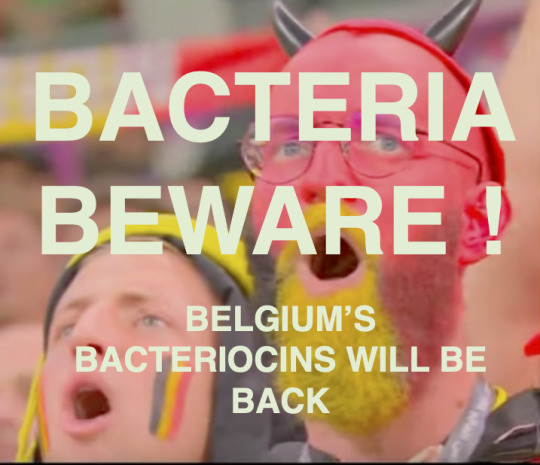
Bacteria Beware -- Belgium's Bacteriocins will be back.
Good bacteria -- Be at ease.
AS2AMR & BIC2025
25 - 28 May, 2025 Dear Colleague, We are excited to announce the upcoming conference “One Health in Focus: Advancing Solutions to Antimicrobial Resistance” (AS2AMR), co-organized with the “BIC2025". This event will take place from May 25 to 28, 2025, at the historic Palace of the Academies in Brussels, Belgium.
Organized by the National Committee for Microbiology (NaCoMi) of the Royal Academies for Science and the Arts of Belgium, in collaboration with the Belgian Society for Microbiology (BSM), this conference will commemorate the 100th anniversary of bacteriocin discovery by the Belgian researcher Prof. André Gratia.
The event will focus on: Tackling Antimicrobial Resistance (AMR) from a One Health perspective (human medicine & animal health; food safety; plant - & environmental health). Exploring data science, regulations, and policies. Highlighting novel technologies and advancements in combating AMR. We are thrilled to invite you to join this interdisciplinary event featuring academics, industry leaders, and policymakers, while celebrating the benchmark excellence of Belgian Microbiologists, on a global stage. Registrations are now open!
Sign up via the link below and check out our website for more details on the full program. https://as2amr.be/ Click here to register! https://eu.eventscloud.com/ereg/index.php?eventid=200284614& Warm regards, Prof. Jacques Mahillon On behalf of the AS2AMR & BIC2025 Organizing Committee
Click here to register! https://eu.eventscloud.com/ereg/index.php?eventid=200284614& Warm regards, Prof. Jacques Mahillon
On behalf of the AS2AMR & BIC2025 Organizing Committee GRATIA’S MICROBIOLOGY, VIROLOGY, CELLULAR LABORATORY TECHNIQUES
1) Microbial agar technique —Suspend bacteria 107-108 in an 0.7 percent agar-agar solution to demonstrate antibiotic or bacteriolytic properties of substances produced by colonies of bacteria or molds — reported to Selman Waksman, actinomycetes specialist and discoverer of several bacteria-produced antibiotics, by Maurice Welsch staying in the USA.
2) Cellophane sheet procedure — Affix a cellophane sheet to the microbial agar containing a sensitive germ and seeded with a culture of an antibiotic germ to assess the degree of diffusion by the pores of the cellophane of the substances studied.
3) Double layer technique for the titration of bacteriophages —Used by all bacteriophage specialists since its publication in 1936.
4) Inhibition binding of a bacteriophage to membrane receptors — By the specific antiserum of the phage studied —in collaboration with Willy Mutsaars.
5) Ultracentrifugation using compressed air — Shows the efficient demarcation between virus particles and protein molecules using the famous Hendriot and Huguenard compressed air ultracentrifugue. Please note that ultracentrifugation uses far more G force than the human body can stand, 2 to 5 g. 6) Fractional centrifugation — before its application by other biologists, including Albert Claude. Fill Ebonite tubes with a suspension of virus or protein substances which after centrifugation are frozen and cut into slices whose content is titrated after thawing. The technique shows the differences in sedimentation of the centrifuged elements.
7) Replicas — Affix a piece of sterile cloth to a round wooden block, which is applied to a Petri dish containing bacteriophage plaques. Replicate on a soft agar dish containing specific phage-sensitive bacteria. This ensures the large-scale development of phage particles. Collect and centrifuge the agar where the phage grew. The resulting phage particle titer is surprisingly high. Twenty years later J. Lederberg created a related replication technique for colonies of bacteria on different media, which is used commonly in bacterial genetics.
8) Electron microscopy to identify staphylophages — Gratia does not receive credit for this, due to the Second World War. His electron microscope was taken by the Americans in 1945. German researcher Ruska took pictures of his Staphylophage
#bacteriophage#phage#bacteria#bacteriology#virology#virus#fungi#antibiotics#fermentation#sanitation#epidemiology#immunology#medical research#health#bio pharma#antimicrobial#pandemic#bacteriocin#medical care#healthcare#belgium#pharmacology
2 notes
·
View notes
Text
Top Tools for DAO Development: Best Platforms for 2025
What Is a DAO?
A Decentralized Autonomous Organization (DAO) is a community-led entity with no central authority. Built on blockchain technology, it operates through smart contracts, ensuring transparency and automation in decision-making. Members hold voting rights through governance tokens, enabling them to influence protocol updates, treasury management, and project direction.
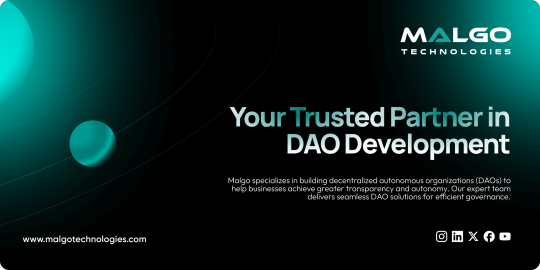
Why Is a DAO Important?
DAOs eliminate traditional hierarchical structures, making governance more democratic and trustless. They are widely used in DeFi, NFT communities, and blockchain-based projects. With secure and transparent mechanisms, DAOs enhance accountability and efficiency in decentralized ecosystems.
DAO Platform Development: Top Solutions for Building Decentralized Organizations
Creating a DAO requires specialized tools and platforms that provide governance frameworks, smart contracts, and automation features. Here are some of the best options for 2025:
Aragon – Offers modular governance solutions, enabling the creation of DAOs with customizable smart contracts.
Colony – Focuses on reputation-based governance, ensuring fair decision-making.
DAOstack – Provides a scalable framework with robust governance mechanisms.
MolochDAO – Designed for grant funding DAOs with simplified governance.
Snapshot – A gasless voting tool used for off-chain governance.
Smart Contract Development for DAO: Best Tools for Secure Automation
Smart contracts form the backbone of DAO operations, executing governance rules autonomously. Security and efficiency are crucial when developing these contracts. Leading tools for 2025 include:
Solidity – The most widely used programming language for Ethereum-based smart contracts.
OpenZeppelin – A security library for developing standardized and audited smart contracts.
Hardhat – A testing and development framework with debugging features.
Remix IDE – A browser-based tool for writing, testing, and deploying smart contracts.
Truffle Suite – A powerful development environment for Ethereum applications.
DAO dApp Development: Essential Platforms for Building Decentralized Apps
Decentralized applications (dApps) play a key role in DAO ecosystems, offering interfaces for governance, treasury management, and voting. Essential platforms for building DAO-focused dApps include:
Moralis – Provides blockchain API services, reducing development complexity.
Thirdweb – Simplifies smart contract deployment for DAO dApps.
Alchemy – Offers high-performance APIs for blockchain interactions.
IPFS – A decentralized storage solution for DAO-related data.
The Graph – Indexes blockchain data to improve dApp performance.
Which Blockchain Networks Offer the Best Support for DAO Creation?
Selecting the right blockchain network is vital for DAO functionality. These blockchains provide the best infrastructure for DAO development in 2025:
Ethereum – The most popular choice, backed by extensive developer support and security.
Polygon – A layer-2 scaling solution that reduces transaction costs for DAOs.
Solana – Offers high-speed transactions with minimal fees.
Binance Smart Chain (BSC) – Provides an affordable alternative to Ethereum.
Polkadot – Supports interoperability, allowing DAOs to operate across multiple chains.
Malgo is gaining traction for its high-security infrastructure, making it a competitive option for DAO creation.
How No-Code and Low-Code Tools Are Making DAO Development Easier
No-code and low-code solutions are transforming DAO creation, making it accessible to non-developers. These platforms streamline development without requiring deep technical expertise:
DAOhaus – A no-code platform for launching DAOs instantly.
Superfluid – Enables real-time governance token streaming.
Tally – Simplifies on-chain governance implementation.
Gnosis Safe – Offers multi-signature wallet solutions for DAO treasury management.
Clarity – A smart contract language designed for security and ease of use. Malgo provides low-code tools that streamline DAO governance and automation, reducing the technical barriers to entry.
Final Thoughts As DAOs continue to reshape digital governance, selecting the right tools for development is crucial. Get top-tier DAO development services to build your decentralized organization! From governance frameworks to smart contract solutions, the ecosystem offers a variety of powerful platforms to streamline the process. Among these, Malgo stands out as the top DAO development solution, offering innovative features and seamless integrations. Whether building a DAO from scratch or optimizing an existing one, using the best tools ensures efficiency, security, and scalability for long-term success.
#DAODevelopment#DecentralizedGovernance#BlockchainInnovation#SmartContracts#DeFiIntegration#NFTMarketplace
2 notes
·
View notes